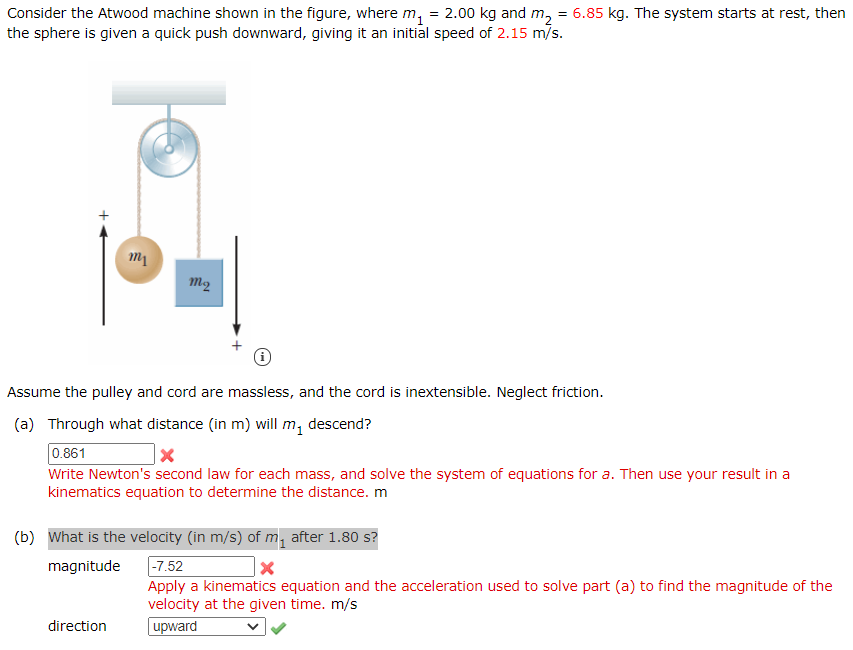Consider the Atwood machine shown in the figure, where m1 = 2.00 kg and m2 = 6.85 kg. The system starts at rest, then the sphere is given a quick push downward, giving it an initial speed of 2.15 m/s. Assume the pulley and cord are massless, and the cord is inextensible. Neglect friction. (a) Through what distance (in m) will m1 descend? (b) What is the velocity (in m/s) of m1 after 1.80 s?
Consider the Atwood machine shown in the figure, where m1 = 2.00 kg and m2 = 6.85 kg. The system starts at rest, then the sphere is given a quick push downward, giving it an initial speed of 2.15 m/s. Assume the pulley and cord are massless, and the cord is inextensible. Neglect friction. (a) Through what distance (in m) will m1 descend? (b) What is the velocity (in m/s) of m1 after 1.80 s?
Glencoe Physics: Principles and Problems, Student Edition
1st Edition
ISBN:9780078807213
Author:Paul W. Zitzewitz
Publisher:Paul W. Zitzewitz
Chapter7: Gravitation
Section: Chapter Questions
Problem 59A
Related questions
Topic Video
Question
100%
Consider the Atwood machine shown in the figure, where
m1 = 2.00 kg
and
m2 = 6.85 kg.
The system starts at rest, then the sphere is given a quick push downward, giving it an initial speed of 2.15 m/s.
Assume the pulley and cord are massless, and the cord is inextensible. Neglect friction.
(a)
Through what distance (in m) will m1 descend?
(b)
What is the velocity (in m/s) of m1 after 1.80 s?

Transcribed Image Text:Consider the Atwood machine shown in the figure, where m, = 2.00 kg and m, = 6.85 kg. The system starts at rest, then
the sphere is given a quick push downward, giving it an initial speed of 2.15 m/s.
m2
Assume the pulley and cord are massless, and the cord is inextensible. Neglect friction.
(a) Through what distance (in m) will m, descend?
0.861
Write Newton's second law for each mass, and solve the system of equations for a. Then use your result in a
kinematics equation to determine the distance. m
(b) What is the velocity (in m/s) of m, after 1.80 s?
|-7.52
Apply a kinematics equation and the acceleration used to solve part (a) to find the magnitude of the
velocity at the given time. m/s
magnitude
direction
upward
Expert Solution
This question has been solved!
Explore an expertly crafted, step-by-step solution for a thorough understanding of key concepts.
This is a popular solution!
Trending now
This is a popular solution!
Step by step
Solved in 6 steps with 1 images

Knowledge Booster
Learn more about
Need a deep-dive on the concept behind this application? Look no further. Learn more about this topic, physics and related others by exploring similar questions and additional content below.Recommended textbooks for you

Glencoe Physics: Principles and Problems, Student…
Physics
ISBN:
9780078807213
Author:
Paul W. Zitzewitz
Publisher:
Glencoe/McGraw-Hill

Glencoe Physics: Principles and Problems, Student…
Physics
ISBN:
9780078807213
Author:
Paul W. Zitzewitz
Publisher:
Glencoe/McGraw-Hill